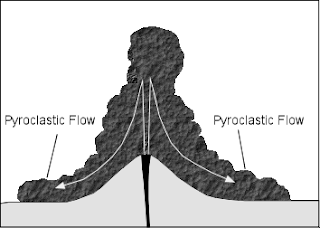Volcanic Eruptions
Tuesday, 1 March 2011
0
comments
Volcanic Eruptions
- In general, magmas that are generated deep within the Earth begin to rise because they are less dense than the surrounding solid rocks.
- As they rise they may encounter a depth or pressure where the dissolved gas no longer can be held in solution in the magma, and the gas begins to form a separate phase (i.e. it makes bubbles just like in a bottle of carbonated beverage when the pressure is reduced).
- When a gas bubble forms, it will also continue to grow in size as pressure is reduced and more of the gas comes out of solution. In other words, the gas bubbles begin to expand.
- If the liquid part of the magma has a low viscosity, then the gas can expand relatively easily. When the magma reaches the Earth's surface, the gas bubble will simply burst, the gas will easily expand to atmospheric pressure, and a non-explosive eruption will occur, usually as a lava flow (Lava is the name we give to a magma when it on the surface of the Earth).
- If the liquid part of the magma has a high viscosity, then the gas will not be able to expand very easily, and thus, pressure will build up inside of the gas bubble(s). When this magma reaches the surface, the gas bubbles will have a high pressure inside, which will cause them to burst explosively on reaching atmospheric pressure. This will cause an explosive volcanic eruption.
Nonexplosive Eruptions
Non explosive eruptions are favored by low gas content and low viscosity magmas (basaltic to andesitic magmas).
- If the viscosity is low, nonexplosive eruptions usually begin with fire fountains due to release of dissolved gases.
- Lava flows are produced on the surface, and these run like liquids down slope, along the lowest areas they can find.
- Lava flows produced by eruptions under water are called pillow lavas.
- If the viscosity is high, but the gas content is low, then the lava will pile up over the vent to produce a lava dome or volcanic dome.
Explosive EruptionsExplosive eruptions are favored by high gas content and high viscosity (andesitic to rhyolitic magmas).
- Explosive bursting of bubbles will fragment the magma into clots of liquid that will cool as they fall through the air. These solid particles become pyroclasts (meaning - hot fragments) and tephra or volcanic ash, which refer to sand- sized or smaller fragments.
- Blocks are angular fragments that were solid when ejected.
- Bombs have an aerodynamic shape indicating they were liquid when ejected.
- Bombs and lapilli that consist mostly of gas bubbles (vesicles) result in a low density highly vesicular rock fragment called pumice.
- Clouds of gas and tephra that rise above a volcano produce an eruption column that can rise up to 45 km into the atmosphere. Eventually the tephra in the eruption column will be picked up by the wind, carried for some distance, and then fall back to the surface as a tephra fall or ash fall.
- If the eruption column collapses a pyroclastic flow will occur, wherein gas and tephra rush down the flanks of the volcano at high speed. This is the most dangerous type of volcanic eruption. The deposits that are produced are called ignimbrites if they contain pumice or pyroclastic flow deposits if they contain non-vesicular blocks.
- If the gas pressure inside the magma is directed outward instead of upward, a lateral blast can occur. When this occurs on the flanks of a lava dome, a pyroclastic flows called a glowing avalanche or nuée ardentes (in French) can also result. Directed blasts often result from sudden exposure of the magma by a landslide or collapse of a lava dome.
TERIMA KASIH ATAS KUNJUNGAN SAUDARA
Judul: Volcanic Eruptions
Ditulis oleh Blogger Koetai
Rating Blog 5 dari 5
Semoga artikel ini bermanfaat bagi saudara. Jika ingin mengutip, baik itu sebagian atau keseluruhan dari isi artikel ini harap menyertakan link dofollow ke http://kicaulebah.blogspot.com/2011/03/volcanic-eruptions.html. Terima kasih sudah singgah membaca artikel ini.Ditulis oleh Blogger Koetai
Rating Blog 5 dari 5













0 comments:
Post a Comment